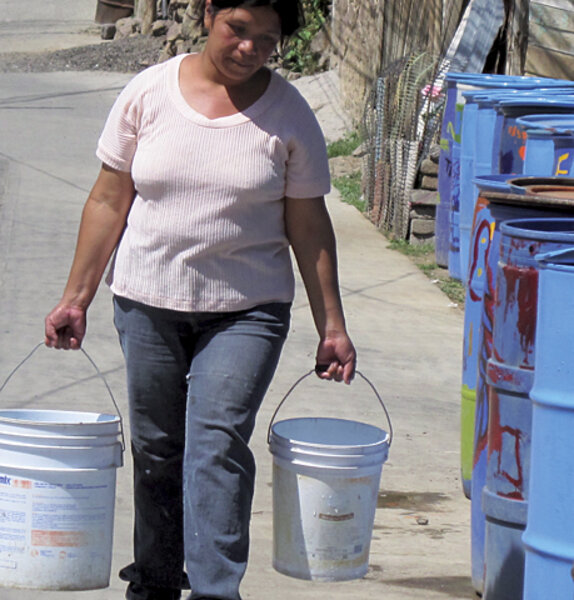Rio+20 challenge: access to water in Mexico City
Loading...
| Mexico City
Light starts to filter through the one-room home Margarita Garcia Velazquez shares with her husband and four children on the fringes of Mexico City, but she cannot turn on a faucet to brush teeth or wash little faces.
In fact, every move she makes with the children, ages 2 to 12 – from cleaning the breakfast dishes to scrubbing the dirt out of school uniforms – requires that she first walk down two dozen steps to the road in front of her house. There await four large barrels of water that hold her entire week's supply of water. Ms. Garcia Velazquez fills her two buckets and then carries them back up again.
Getting water to its 20 million residents is one of Mexico City's most vexing problems. At an altitude of more than 7,300 feet, the city takes water from aquifers that aren't naturally replenished, so it must pump the rest up 3,000 feet to reach residents. Because of sprawl, some 5 percent of Mexico City is not connected to the water supply, says David Vargas, the chief operating officer of Isla Urbana, a nonprofit group that works with residents of Tecalipa, where Garcia Velazquez lives, to build rainwater catchment systems.
Because demand outweighs supply, another 33 percent of Mexico City residents don't have daily access to water.
"It's not like in the US, where you turn on a faucet and there is water, always," Mr. Vargas says.
Latin America is the most urbanized region in the world, and like so many communities in the region, Tecalipa is an illegal settlement and disconnected from the water system. As in other megacities, the politics of water here are fraught. Mexico City must play a balancing act when it comes to illegal settlements like this one, Vargas says – especially since the city doesn't want to send a message that it supports illegal encampments. So for now, Mexico City's initiatives are largely limited to delivering truckloads of water every week to communities like Tecalipa.
Each family's share of water depends on its size: Garcia Velazquez gets four barrels for six members, which is half of the minimum 50 liters (13 gallons) a day the World Health Organization (WHO) recommends per person for basic needs to be met.
Garcia Velazquez's day revolves around water rationing. Women in this community manage their water supplies the way other families balance budgets, accounting for each drop. Garcia Velazquez first washes her white clothes, reuses the water to wash colors, and saves the leftover to wash out the toilet.
"Sometimes I bathe my four children with a single bucket of water," Garcia Velazquez says. "Water is what we are always thinking about."
Access to water is particularly bad during the dry season, which runs from late spring to fall: Citywide shortages are common. But in Tecalipa, it means that piles of dirty clothes lie strewn across the house and dirty dishes pile up on a counter outside. When it starts to rain, Garcia Velazquez can let down her guard. But in a cruel twist, the rainy season is when her husband's life gets more complicated: Despite chronic water shortages, Mexico City is also prone to flooding during torrential rainfalls.
With pressure on aquifers, the city is sinking, taxing the drainage system. So streets fill with rain, backing up already snarled traffic and turning commutes into hours-long affairs.
"Sometimes he comes home soaking wet," says Garcia Velazquez of her husband, who works as a welder in the city. When traffic is at a standstill, he gets off the bus and walks home.
The threat of serious flooding is so big that the city is undertaking a massive sewer tunnel project that includes plans for water treatment to help on the supply side.
On a recent day, down the hill from Garcia Velazquez's house, her sister Carmen's 4-year-old rushes up to his mom. "Water, water," he says. She pours him a glass. All the water they drink they buy, in 20-liter containers, spending about $10 a week, or about a 12th of their family income. They, like 11 percent of the world's population, according to the WHO, lack access to safe drinking water.
Carmen Garcia Velazquez says water dominates their community, rainy season or not. On weeks with public holidays falling on Mondays, for example, the water truck never arrives. So residents often pool money to buy their own private supply. And at least twice a month, she says, the truck arrives without enough water, so some families are left lacking. "There can be fights in the community," she says. "Most will share a bucket of their own water, but some don't want to." She says she tries to help as she can: If a family hasn't managed their water well one week, she'll allow the children to bathe at her house before school. "That is what bothers me the most, thinking about the hygiene of my children," she says.
When Carmen goes to bed at night, she lets herself think about what it would be like to have a faucet with a limitless supply. She thinks about cleaning the blankets on the beds and enlisting the kids in chores. But for now she and her sister can't afford a careless action, a bucket spilled on the way up the steps, or a child washing a pair of tennis shoes with the same amount of water a mother could wash the entire household's clothes. "It's not worth it," she says.





